open hood CADILLAC ESCALADE 2007 3.G Owners Manual
[x] Cancel search | Manufacturer: CADILLAC, Model Year: 2007, Model line: ESCALADE, Model: CADILLAC ESCALADE 2007 3.GPages: 574, PDF Size: 2.89 MB
Page 144 of 574
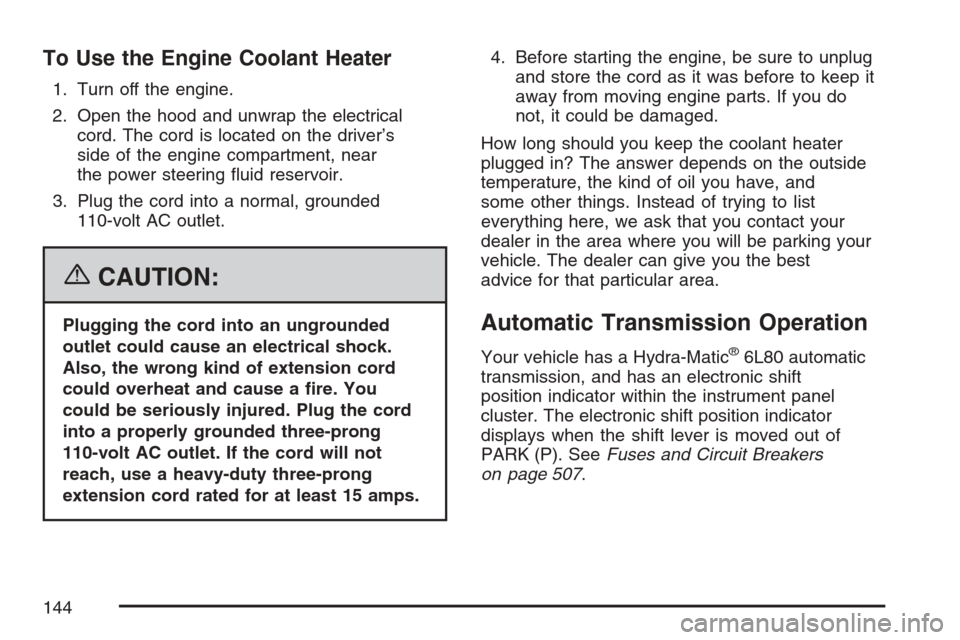
To Use the Engine Coolant Heater
1. Turn off the engine.
2. Open the hood and unwrap the electrical
cord. The cord is located on the driver’s
side of the engine compartment, near
the power steering �uid reservoir.
3. Plug the cord into a normal, grounded
110-volt AC outlet.
{CAUTION:
Plugging the cord into an ungrounded
outlet could cause an electrical shock.
Also, the wrong kind of extension cord
could overheat and cause a �re. You
could be seriously injured. Plug the cord
into a properly grounded three-prong
110-volt AC outlet. If the cord will not
reach, use a heavy-duty three-prong
extension cord rated for at least 15 amps.4. Before starting the engine, be sure to unplug
and store the cord as it was before to keep it
away from moving engine parts. If you do
not, it could be damaged.
How long should you keep the coolant heater
plugged in? The answer depends on the outside
temperature, the kind of oil you have, and
some other things. Instead of trying to list
everything here, we ask that you contact your
dealer in the area where you will be parking your
vehicle. The dealer can give you the best
advice for that particular area.Automatic Transmission Operation
Your vehicle has a Hydra-Matic®6L80 automatic
transmission, and has an electronic shift
position indicator within the instrument panel
cluster. The electronic shift position indicator
displays when the shift lever is moved out of
PARK (P). SeeFuses and Circuit Breakers
on page 507.
144
Page 253 of 574
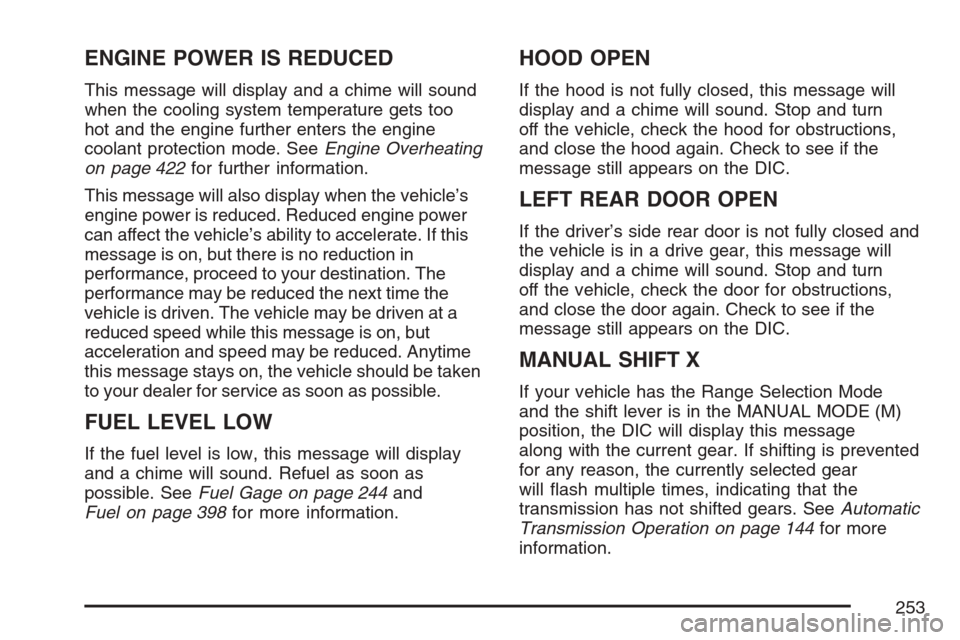
ENGINE POWER IS REDUCED
This message will display and a chime will sound
when the cooling system temperature gets too
hot and the engine further enters the engine
coolant protection mode. SeeEngine Overheating
on page 422for further information.
This message will also display when the vehicle’s
engine power is reduced. Reduced engine power
can affect the vehicle’s ability to accelerate. If this
message is on, but there is no reduction in
performance, proceed to your destination. The
performance may be reduced the next time the
vehicle is driven. The vehicle may be driven at a
reduced speed while this message is on, but
acceleration and speed may be reduced. Anytime
this message stays on, the vehicle should be taken
to your dealer for service as soon as possible.
FUEL LEVEL LOW
If the fuel level is low, this message will display
and a chime will sound. Refuel as soon as
possible. SeeFuel Gage on page 244and
Fuel on page 398for more information.
HOOD OPEN
If the hood is not fully closed, this message will
display and a chime will sound. Stop and turn
off the vehicle, check the hood for obstructions,
and close the hood again. Check to see if the
message still appears on the DIC.
LEFT REAR DOOR OPEN
If the driver’s side rear door is not fully closed and
the vehicle is in a drive gear, this message will
display and a chime will sound. Stop and turn
off the vehicle, check the door for obstructions,
and close the door again. Check to see if the
message still appears on the DIC.
MANUAL SHIFT X
If your vehicle has the Range Selection Mode
and the shift lever is in the MANUAL MODE (M)
position, the DIC will display this message
along with the current gear. If shifting is prevented
for any reason, the currently selected gear
will �ash multiple times, indicating that the
transmission has not shifted gears. SeeAutomatic
Transmission Operation on page 144for more
information.
253
Page 405 of 574

Hood Release
To open the hood do the following:
1. Pull the handle with
this symbol on it. It
is located inside
the vehicle to
the lower left of the
steering wheel.
2. Then go to the front of the vehicle and locate
the secondary hood release, near the center
of the grille.
3. Push the secondary hood release to the right.
4. Lift the hood.
Before closing the hood, be sure all the �ller
caps are on properly. Then bring the hood from
full open to within 6 inches (152 mm) from
the closed position, pause, then push the front
center of the hood with a swift, �rm motion
to fully close the hood.
405
Page 406 of 574

Engine Compartment Overview
When you open the hood on the 6.2L engine here is what you will see:
406
Page 422 of 574
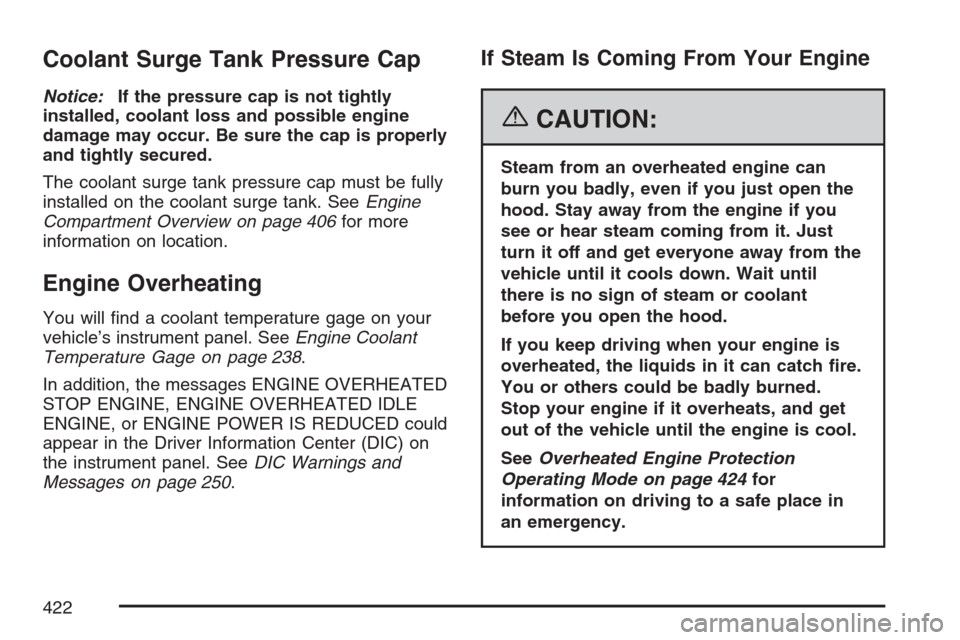
Coolant Surge Tank Pressure Cap
Notice:If the pressure cap is not tightly
installed, coolant loss and possible engine
damage may occur. Be sure the cap is properly
and tightly secured.
The coolant surge tank pressure cap must be fully
installed on the coolant surge tank. SeeEngine
Compartment Overview on page 406for more
information on location.
Engine Overheating
You will �nd a coolant temperature gage on your
vehicle’s instrument panel. SeeEngine Coolant
Temperature Gage on page 238.
In addition, the messages ENGINE OVERHEATED
STOP ENGINE, ENGINE OVERHEATED IDLE
ENGINE, or ENGINE POWER IS REDUCED could
appear in the Driver Information Center (DIC) on
the instrument panel. SeeDIC Warnings and
Messages on page 250.
If Steam Is Coming From Your Engine
{CAUTION:
Steam from an overheated engine can
burn you badly, even if you just open the
hood. Stay away from the engine if you
see or hear steam coming from it. Just
turn it off and get everyone away from the
vehicle until it cools down. Wait until
there is no sign of steam or coolant
before you open the hood.
If you keep driving when your engine is
overheated, the liquids in it can catch �re.
You or others could be badly burned.
Stop your engine if it overheats, and get
out of the vehicle until the engine is cool.
SeeOverheated Engine Protection
Operating Mode on page 424for
information on driving to a safe place in
an emergency.
422
Page 438 of 574
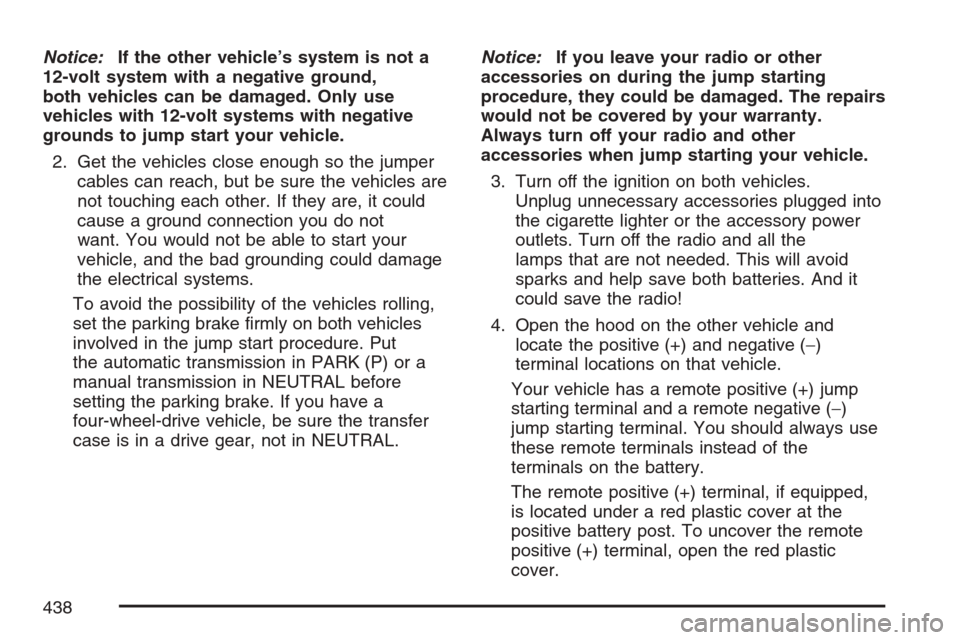
Notice:If the other vehicle’s system is not a
12-volt system with a negative ground,
both vehicles can be damaged. Only use
vehicles with 12-volt systems with negative
grounds to jump start your vehicle.
2. Get the vehicles close enough so the jumper
cables can reach, but be sure the vehicles are
not touching each other. If they are, it could
cause a ground connection you do not
want. You would not be able to start your
vehicle, and the bad grounding could damage
the electrical systems.
To avoid the possibility of the vehicles rolling,
set the parking brake �rmly on both vehicles
involved in the jump start procedure. Put
the automatic transmission in PARK (P) or a
manual transmission in NEUTRAL before
setting the parking brake. If you have a
four-wheel-drive vehicle, be sure the transfer
case is in a drive gear, not in NEUTRAL.Notice:If you leave your radio or other
accessories on during the jump starting
procedure, they could be damaged. The repairs
would not be covered by your warranty.
Always turn off your radio and other
accessories when jump starting your vehicle.
3. Turn off the ignition on both vehicles.
Unplug unnecessary accessories plugged into
the cigarette lighter or the accessory power
outlets. Turn off the radio and all the
lamps that are not needed. This will avoid
sparks and help save both batteries. And it
could save the radio!
4. Open the hood on the other vehicle and
locate the positive (+) and negative (−)
terminal locations on that vehicle.
Your vehicle has a remote positive (+) jump
starting terminal and a remote negative (−)
jump starting terminal. You should always use
these remote terminals instead of the
terminals on the battery.
The remote positive (+) terminal, if equipped,
is located under a red plastic cover at the
positive battery post. To uncover the remote
positive (+) terminal, open the red plastic
cover.
438
Page 447 of 574
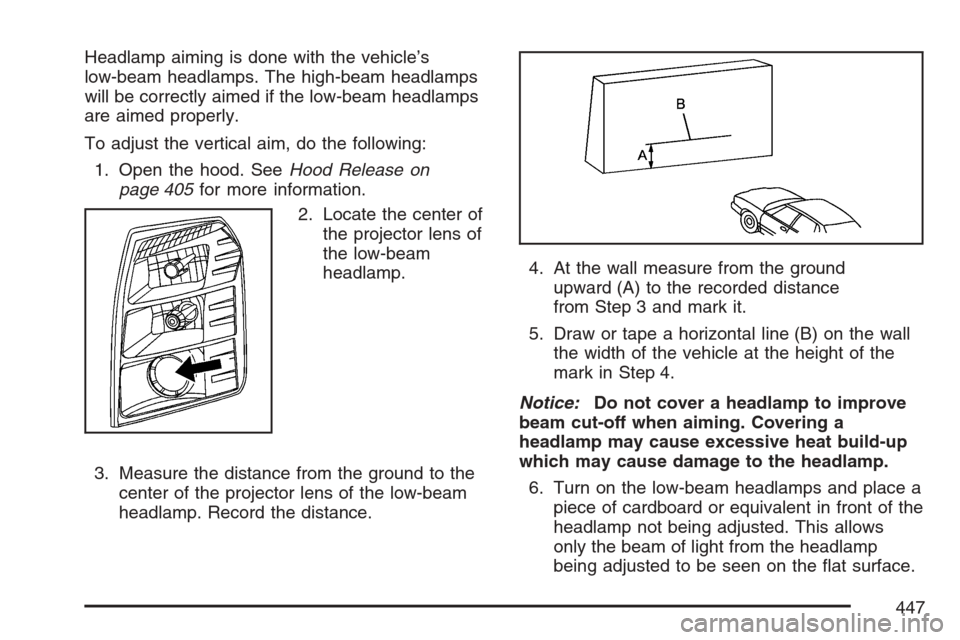
Headlamp aiming is done with the vehicle’s
low-beam headlamps. The high-beam headlamps
will be correctly aimed if the low-beam headlamps
are aimed properly.
To adjust the vertical aim, do the following:
1. Open the hood. SeeHood Release on
page 405for more information.
2. Locate the center of
the projector lens of
the low-beam
headlamp.
3. Measure the distance from the ground to the
center of the projector lens of the low-beam
headlamp. Record the distance.4. At the wall measure from the ground
upward (A) to the recorded distance
from Step 3 and mark it.
5. Draw or tape a horizontal line (B) on the wall
the width of the vehicle at the height of the
mark in Step 4.
Notice:Do not cover a headlamp to improve
beam cut-off when aiming. Covering a
headlamp may cause excessive heat build-up
which may cause damage to the headlamp.
6. Turn on the low-beam headlamps and place a
piece of cardboard or equivalent in front of the
headlamp not being adjusted. This allows
only the beam of light from the headlamp
being adjusted to be seen on the �at surface.
447
Page 526 of 574
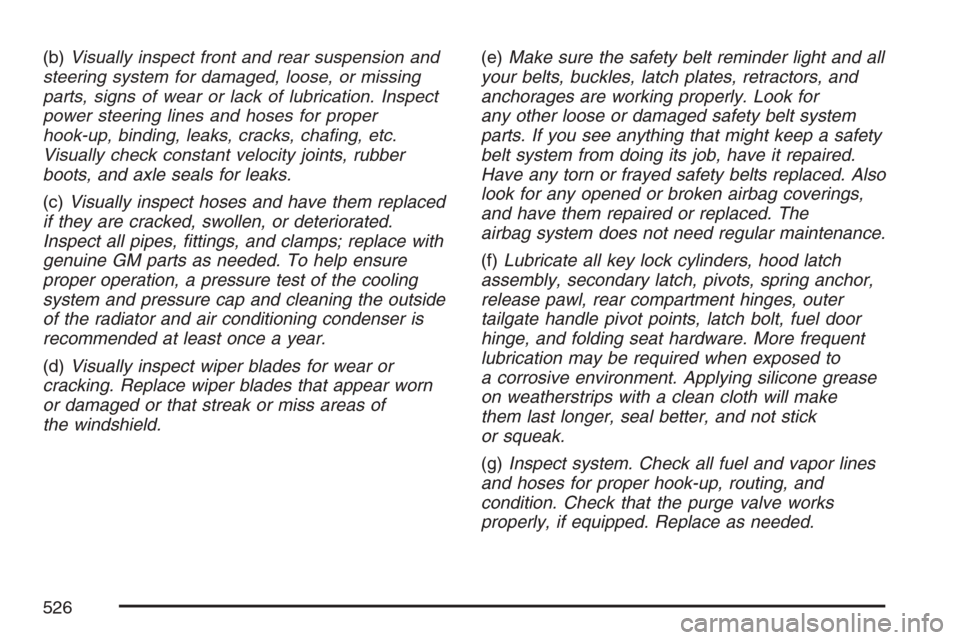
(b)Visually inspect front and rear suspension and
steering system for damaged, loose, or missing
parts, signs of wear or lack of lubrication. Inspect
power steering lines and hoses for proper
hook-up, binding, leaks, cracks, cha�ng, etc.
Visually check constant velocity joints, rubber
boots, and axle seals for leaks.
(c)Visually inspect hoses and have them replaced
if they are cracked, swollen, or deteriorated.
Inspect all pipes, �ttings, and clamps; replace with
genuine GM parts as needed. To help ensure
proper operation, a pressure test of the cooling
system and pressure cap and cleaning the outside
of the radiator and air conditioning condenser is
recommended at least once a year.
(d)Visually inspect wiper blades for wear or
cracking. Replace wiper blades that appear worn
or damaged or that streak or miss areas of
the windshield.(e)Make sure the safety belt reminder light and all
your belts, buckles, latch plates, retractors, and
anchorages are working properly. Look for
any other loose or damaged safety belt system
parts. If you see anything that might keep a safety
belt system from doing its job, have it repaired.
Have any torn or frayed safety belts replaced. Also
look for any opened or broken airbag coverings,
and have them repaired or replaced. The
airbag system does not need regular maintenance.
(f)Lubricate all key lock cylinders, hood latch
assembly, secondary latch, pivots, spring anchor,
release pawl, rear compartment hinges, outer
tailgate handle pivot points, latch bolt, fuel door
hinge, and folding seat hardware. More frequent
lubrication may be required when exposed to
a corrosive environment. Applying silicone grease
on weatherstrips with a clean cloth will make
them last longer, seal better, and not stick
or squeak.
(g)Inspect system. Check all fuel and vapor lines
and hoses for proper hook-up, routing, and
condition. Check that the purge valve works
properly, if equipped. Replace as needed.
526
Page 531 of 574
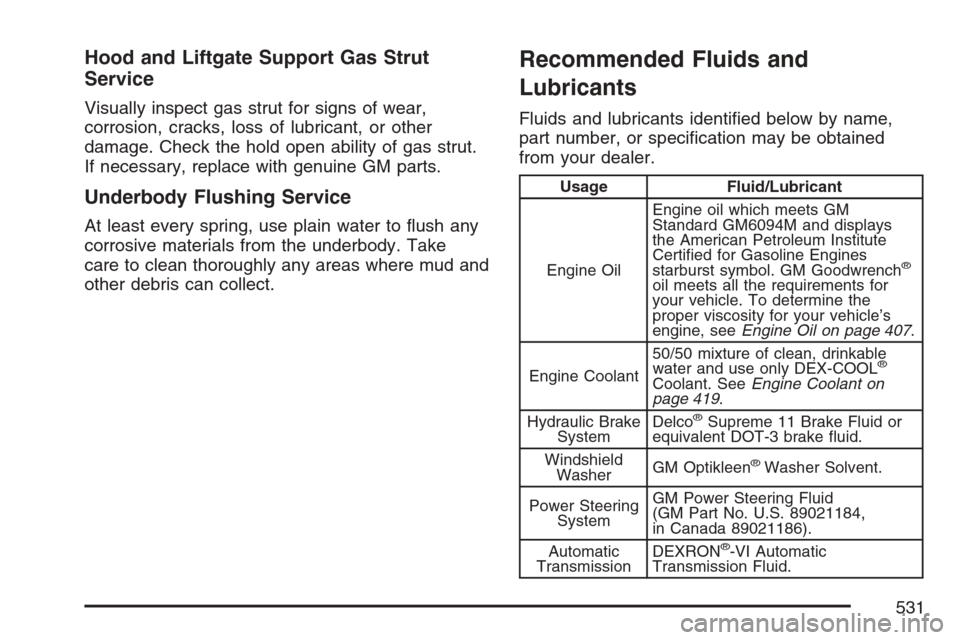
Hood and Liftgate Support Gas Strut
Service
Visually inspect gas strut for signs of wear,
corrosion, cracks, loss of lubricant, or other
damage. Check the hold open ability of gas strut.
If necessary, replace with genuine GM parts.
Underbody Flushing Service
At least every spring, use plain water to �ush any
corrosive materials from the underbody. Take
care to clean thoroughly any areas where mud and
other debris can collect.
Recommended Fluids and
Lubricants
Fluids and lubricants identi�ed below by name,
part number, or speci�cation may be obtained
from your dealer.
Usage Fluid/Lubricant
Engine OilEngine oil which meets GM
Standard GM6094M and displays
the American Petroleum Institute
Certi�ed for Gasoline Engines
starburst symbol. GM Goodwrench
®
oil meets all the requirements for
your vehicle. To determine the
proper viscosity for your vehicle’s
engine, seeEngine Oil on page 407.
Engine Coolant50/50 mixture of clean, drinkable
water and use only DEX-COOL
®
Coolant. SeeEngine Coolant on
page 419.
Hydraulic Brake
SystemDelco
®Supreme 11 Brake Fluid or
equivalent DOT-3 brake �uid.
Windshield
WasherGM Optikleen
®Washer Solvent.
Power Steering
SystemGM Power Steering Fluid
(GM Part No. U.S. 89021184,
in Canada 89021186).
Automatic
TransmissionDEXRON
®-VI Automatic
Transmission Fluid.
531
Page 564 of 574
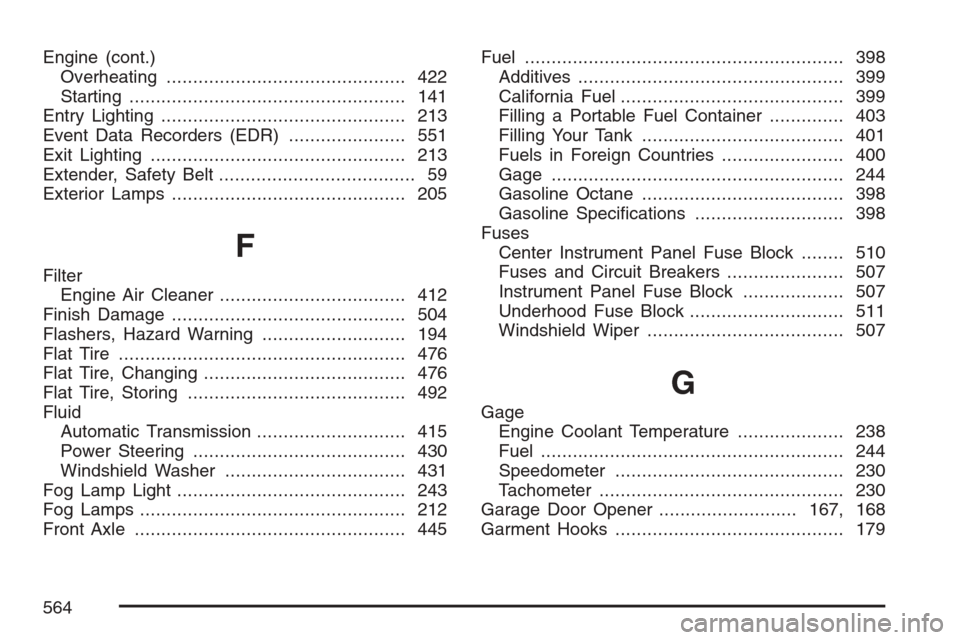
Engine (cont.)
Overheating............................................. 422
Starting.................................................... 141
Entry Lighting.............................................. 213
Event Data Recorders (EDR)...................... 551
Exit Lighting................................................ 213
Extender, Safety Belt..................................... 59
Exterior Lamps............................................ 205
F
Filter
Engine Air Cleaner................................... 412
Finish Damage............................................ 504
Flashers, Hazard Warning........................... 194
Flat Tire...................................................... 476
Flat Tire, Changing...................................... 476
Flat Tire, Storing......................................... 492
Fluid
Automatic Transmission............................ 415
Power Steering........................................ 430
Windshield Washer.................................. 431
Fog Lamp Light........................................... 243
Fog Lamps.................................................. 212
Front Axle................................................... 445Fuel............................................................ 398
Additives.................................................. 399
California Fuel.......................................... 399
Filling a Portable Fuel Container.............. 403
Filling Your Tank...................................... 401
Fuels in Foreign Countries....................... 400
Gage....................................................... 244
Gasoline Octane...................................... 398
Gasoline Speci�cations............................ 398
Fuses
Center Instrument Panel Fuse Block........ 510
Fuses and Circuit Breakers...................... 507
Instrument Panel Fuse Block................... 507
Underhood Fuse Block............................. 511
Windshield Wiper..................................... 507
G
Gage
Engine Coolant Temperature.................... 238
Fuel......................................................... 244
Speedometer........................................... 230
Tachometer.............................................. 230
Garage Door Opener..........................167, 168
Garment Hooks........................................... 179
564